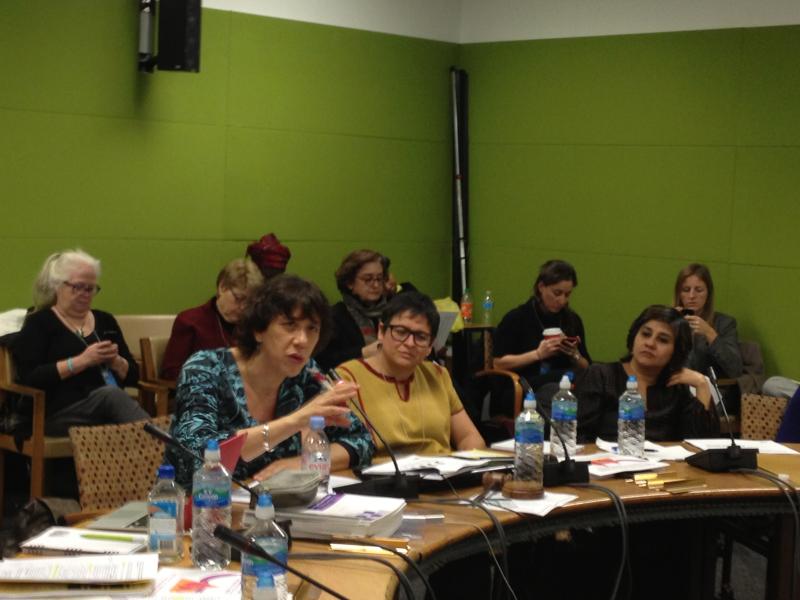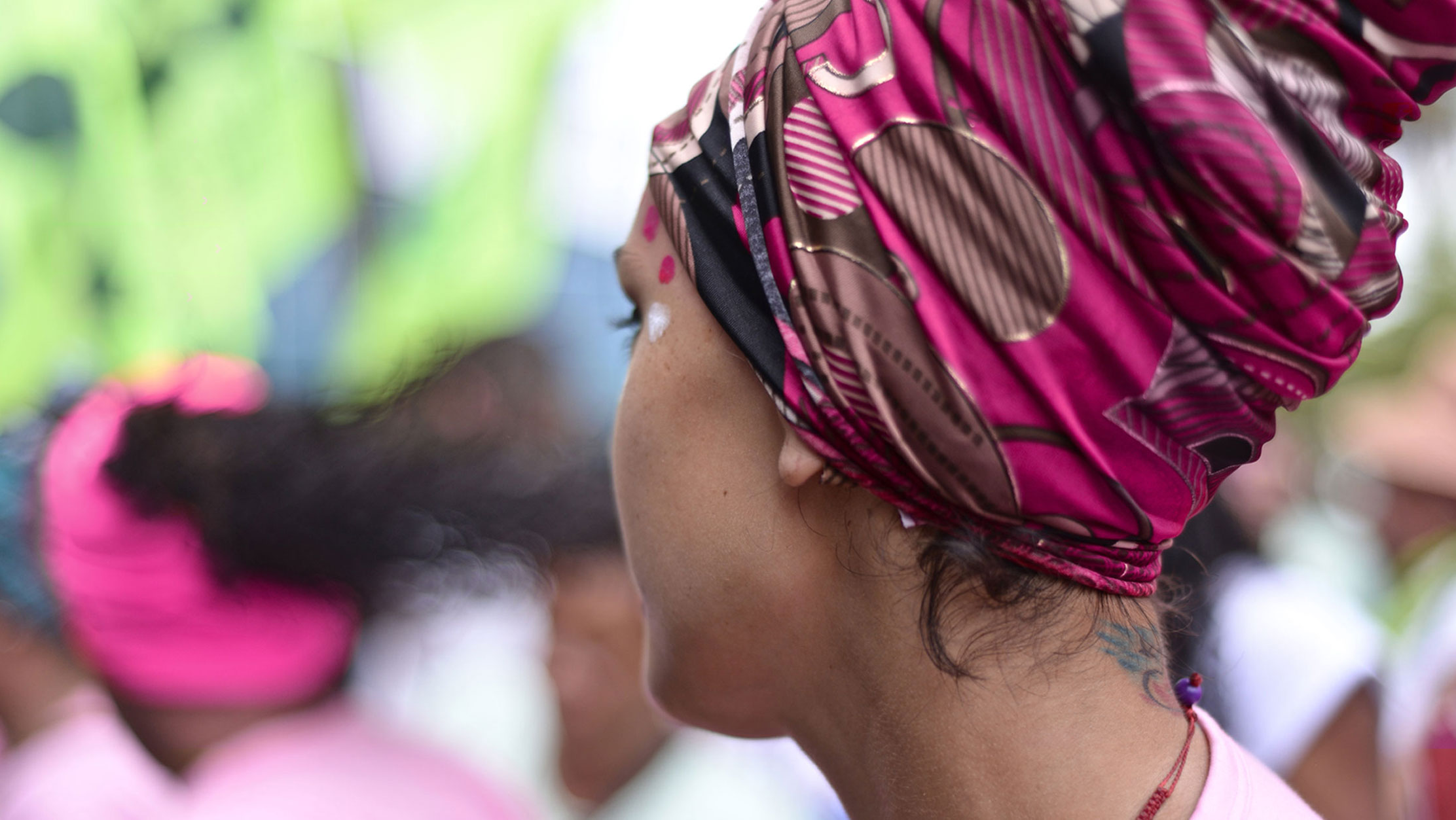FRIDAY FILE: A unique ‘aggregate analysis’ of the Dutch MDG3 Fund, conducted by AWID, with input from 33 fund recipient organisations provides a unique opportunity to highlight the broad range of multi-sectoral strategies that organisations are using a to tackle gender based violence (GBV) and the importance of continued and sustained funding for the work they do.
By Gabriela De Cicco and Srilatha Batliwala
Thirty-three of the 45 (73%) MDG3 grantee organizations took part in the analysis that AWID began in 2010. Twenty-four (72%) of them were specifically committed to promoting women’s human rights and 28 (83%) worked to reduce or eliminate violence against women, the priority theme for the 57thsession of the Commission on the Status of Women (CSW 57) currently taking place in New York.
On March 7, in a panel co-sponsored by the Dutch Ministry of Foreign Affairs, AWID presented research highlights from the case of the MDG3 Fund, which stands as striking example of the power of high impact investment to eliminate and prevent violence against women
The uniqueness of the MDG3 Fund
On October 17, 2008, the Dutch Foreign Affairs Ministry issued the official announcement launching the MDG3 Fund, whose first cycle would provide three-year grants of 82 million euros[i]to a total of 45 networks, organizations and funds around the world, aimed at reducing violence against women, enhancing women's economic independence and rights, and increasing participation and representation of women in politics and public administration.

The launch of the MDG3 Fund by the Dutch Government – at least partly in response to the findings of AWID’s first “Where is the Money” survey in 2006 – represents the single largest bilateral fund ever created aimed at supporting civil society organizations working on gender equality and women’s rights in history. In fact, as the largest pot of money ever made available from a single donor, it is possibly the biggest infusion of resources since support for gender equality began in the 1970s, and reflective of the kind of commitment required if progress is to be made in turning commitments and rhetoric on advancing gender equality into actual practice.
Rationale for learning from a historic experiment
Given the unique scale of the resources the MDG3 Fund made available for women’s rights, AWID felt that the Fund presented a historic opportunity to demonstrate the aggregate impact of this investment – to analyze what was achieved collectively, by all the grant recipients, cutting across organization, project, location, issue, and strategy. AWID therefore seized the chance to work alongside other grantees and develop a new methodology to analyze the impact and achievements of the organizations to generate a “big picture” of the changes wrought over a four-year period
Making the case for resourcing GBV initiatives
Twenty-eight of the 33 AWID aggregate analysis survey respondents worked specifically to reduce or eliminate violence against women. Given the rigor of the selection process for the MDG3 grants, these organizations represent some of the best and the brightest innovators in the women’s movement globally, regionally, and nationally. The learning they have generated through their work over these four years constitutes some of the most cutting-edge work in advancing women’s rights.
One of the key findings of the survey was the wide range of strategies women’s rights organisations use to address GBV. These strategies include[ii]creating new strategies and tools (70%); political and legal advocacy (63%); building leadership and capacity to act on GBV (59%); building alliances, networks, across movements (52%); urgent actions, redress, recovery and healing (37%); mass mobilizations and campaigns (33%); working with men; media and ICT based strategies (19%) and research and knowledge building (15%). Even more important, is the finding that 20 of the 28 (71%) organisations surveyed used three to five strategies to advance their cause. Three organisations (11%) used six or more strategies, while four organisations (15%) only used up to two strategies.
Organisations developed an array of innovative strategies for linking GBV to a range of issues often considered unrelated to violence against women and girls (VAWG). [iii]Breakthrough (India) launched a major nationwide multimedia campaign on domestic violence called “Ring the Bell” while simultaneously doing advocacy work empowering women to demand their rights. Calandria, in Bolivia and Peru, did work linking GBV to political and economic empowerment by creating women’s bodies in the provincial government and local plan against VAW, by developing and using a Gender Agenda as an advocacy tool, and by creating women’s emergency centres. Calandria further helped build women’s networks, while radio was used as part of an education and sensitisation tool to modify and promote new behaviours around VAW. AWID launched a new strategic initiative on women human rights defenders (WHRDs) to strengthen the work of international and regional coalitions, to contribute to the understanding of and responses to religious fundamentalisms and promoting exchange of strategies and actions being advanced by feminist across the world.
Some groups were able to create stronger and more effective mechanisms to prevent VAW, while others worked to raise public awareness and mobilized communities to act against VAW. But, whether it was Just Associates’ work forging alliances to increase the safety of women human rights defenders; CREA’s pioneering research on violence against lesbians, disabled women and women sex workers in South Asia, KARAMA’s first-ever study measuring the cost of VAW in Egypt and the establishment of a multi-sectoral coalition with members from various disciplines including law, politics, economics, education, arts, culture and media to develop a more comprehensive analysis and approach to VAW or MIFUMI’s mobilizing to lobby for the domestic violence bill (passed in November 2009) - the most common trend found was the use of diverse and multiple strategies to address GBV.
This illustrates how interconnected the work of GBV is and that a multi-faceted approach with a mix of strategies is needed that demonstrates an understanding of how VAW is linked not only to internalized beliefs and attitudes but also public policies and services, and not only to women’s disempowerment in the private domain but also their economic marginalization and the importance of their presence, voice and participation in the public sphere.
Dealing with backlash and fundamentalism
While there has been a marked improvement in the area of women’s human rights globally, women’s rights advocates and organisations increasingly have to spend time and their diminishing resources protecting already agreed rights from a conservative and fundamentalist opposition, rather than advancing rights and implementing the strategies that have been developed.
MDG3 Fund grantees used a range of strategies to address rising fundamentalisms, including work to prevent the introduction of stricter legal codes; initiatives to prevent and oppose regressive measure on sexual and reproductive rights, such as penalising emergency contraceptive pills and mobilising to resist negative and regressive legislation and policy.
The aggregate analysis shows that high-impact and multi-year funding enables women’s groups and networks to protect laws and policies that advance women’s rights as human rights and advocate for new ones to neutralize backlash. It allows them to create even bigger public pressure and visibility for women’s rights issues.
Why these achievements matter
Small, localized and isolated efforts that cannot be scaled up and cannot mobilize and organize a larger number of women and their communities against gender discrimination, are not sustainable and do not make a larger difference. It is also well documented that merely converting millions of women into project “beneficiaries” rather than agents of change, is also not a transformative strategy. Corresponding political will is critical to ensure that the governance and justice systems provide enabling conditions for the realisation of women’s rights as human rights - holding on to gains and pushing back regressive laws and policies.
This historical commitment to gender equity and women´s empowerment allowed women’s movements to broaden their influence, enabling them to undertake new projects that had a greater direct impact. Importantly it also supported the creation and systematization of knowledge, which is rare in today’s funding environment.
The aggregate case gives women’s rights advocates and organisations cause to celebrate the gains and prepare for the continued struggle for women’s rights in a context of declining resources and the increasing violence of the range of forces aligned against the women’s movement’s agenda of gender equality and women’s rights. AWID hopes to use this as a powerful “evidence-based” advocacy tool for making a bigger and collective case for why major resources for women’s rights and gender equality work is integral to global social justice. It provides an opportunity to express the individual achievements into more profound and informative insights about how real commitment with the corresponding resources enable women to make change happen.
On 9th March AWID will present key findings from the aggregate analysis of the MDG3 Fund at a session entitled Successful Strategies and Funding Mechanisms to Eradicate Violence Against Women: Women Moving Mountains
*Women moving mountains, AWID’s Independent Assessment of the Global Impact of the MDG3 Fund - AWID Research Team: Srilatha Batliwala, Khoshnam Hamid, Cindy Clark, Sarah Rosenhek & Julia Miller, 2012.
----
[i] EUR 70 million first and then EUR 12 million more through the extension approved in 2011
[ii] Numbers in brackets indicate percentage of organizations working on GBV who use these strategies.
[iii] Please note that the examples we used here represent only a handful of the grantee strategies shared with us that organisations are using to counter VAW
